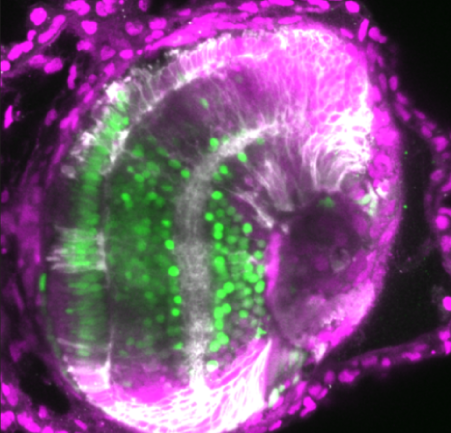
Zebrafish eye: Wild type cells that were introduced by transplantation (marked in white and green) rescued they eye and made sure it has the correct size.
During cell division in animal cells, the regulator of this process called centrosome can erroneously be duplicated. This can have serious consequences: Supernumerary centrosomes have been associated with diseases like cancer and microcephaly.
An MPI-CBG research team of the Norden Lab studied the response of individual cells to supernumerary centrosomes centriole in vivo and across various different tissues. Zebrafish were the preferred choice to do this, since the embryos are transparent and can thus be observed easily. One of the findings was that centrosome over- duplication in neuroepithelial cells leads to cell death due to bi-nucleation. Interestingly, however, cells that only inherit one nucleus survive despite problems in genome separation. The risk of binucleation in neuroepithelial cells occurs at each cell division, which means another coin toss of life or death – so proliferation is the bottleneck for successful tissue maturation. When cells make it to the differentiation stage without death they surprisingly can make all retinal neurons.
The research team could also show that the presence of healthy cells can rescue some of the tissue abnormalities: they can compensate the loss of cell death.
Edo Dzafic, Paulina J. Strzyz, Michaela Wilsch-Bräuninger and Caren Norden:
Centriole amplification in zebrafish affects proliferation and survival but not differentiation of neural progenitor cells
Cell Reports, 24 September 2015